YAMAHA FX SHO 2012 Manual Online
Manufacturer: YAMAHA, Model Year: 2012, Model line: FX SHO, Model: YAMAHA FX SHO 2012Pages: 116, PDF Size: 4.49 MB
Page 81 of 116
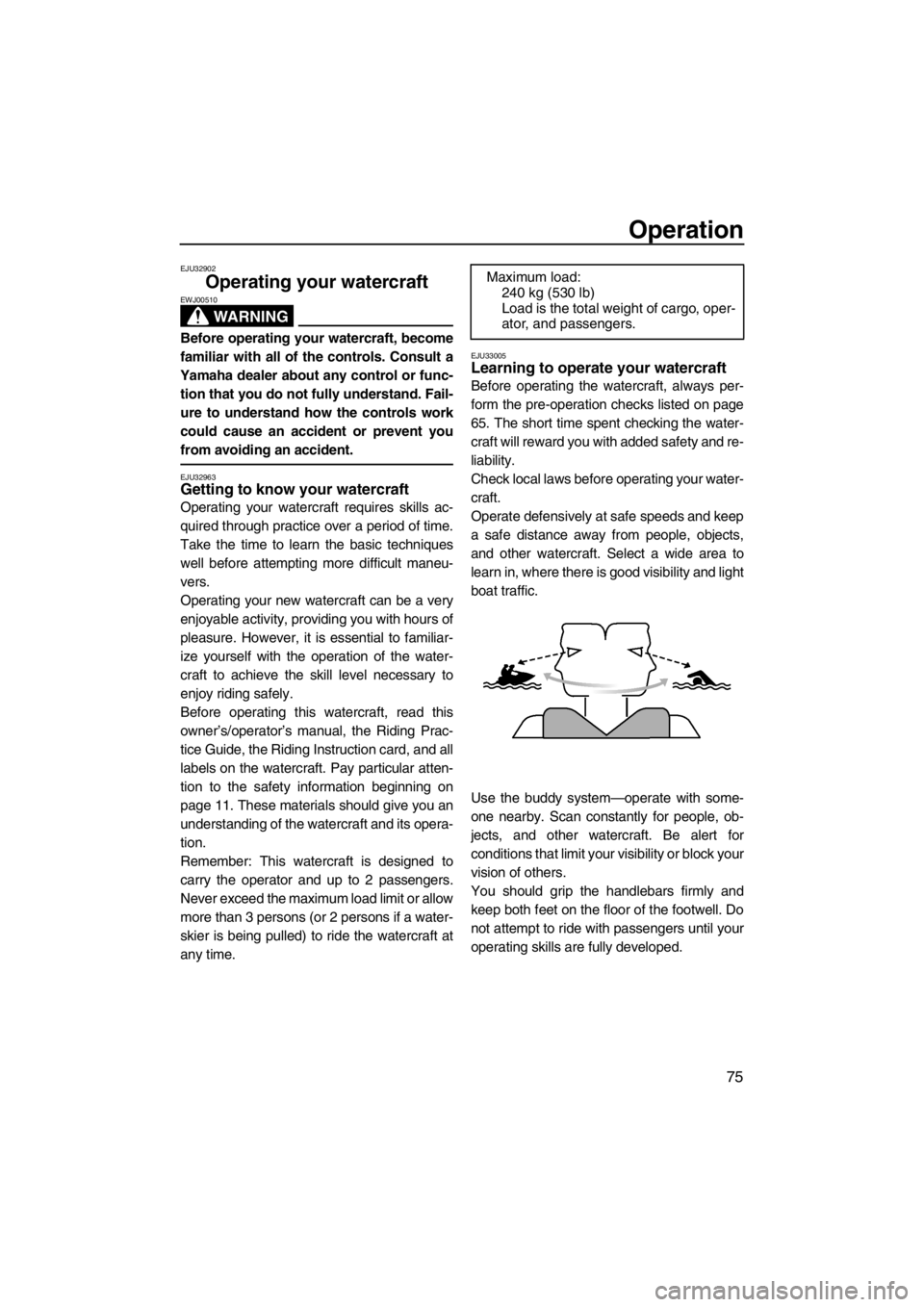
Operation
75
EJU32902
Operating your watercraft
WARNING
EWJ00510
Before operating your watercraft, become
familiar with all of the controls. Consult a
Yamaha dealer about any control or func-
tion that you do not fully understand. Fail-
ure to understand how the controls work
could cause an accident or prevent you
from avoiding an accident.
EJU32963Getting to know your watercraft
Operating your watercraft requires skills ac-
quired through practice over a period of time.
Take the time to learn the basic techniques
well before attempting more difficult maneu-
vers.
Operating your new watercraft can be a very
enjoyable activity, providing you with hours of
pleasure. However, it is essential to familiar-
ize yourself with the operation of the water-
craft to achieve the skill level necessary to
enjoy riding safely.
Before operating this watercraft, read this
owner’s/operator’s manual, the Riding Prac-
tice Guide, the Riding Instruction card, and all
labels on the watercraft. Pay particular atten-
tion to the safety information beginning on
page 11. These materials should give you an
understanding of the watercraft and its opera-
tion.
Remember: This watercraft is designed to
carry the operator and up to 2 passengers.
Never exceed the maximum load limit or allow
more than 3 persons (or 2 persons if a water-
skier is being pulled) to ride the watercraft at
any time.
EJU33005Learning to operate your watercraft
Before operating the watercraft, always per-
form the pre-operation checks listed on page
65. The short time spent checking the water-
craft will reward you with added safety and re-
liability.
Check local laws before operating your water-
craft.
Operate defensively at safe speeds and keep
a safe distance away from people, objects,
and other watercraft. Select a wide area to
learn in, where there is good visibility and light
boat traffic.
Use the buddy system—operate with some-
one nearby. Scan constantly for people, ob-
jects, and other watercraft. Be alert for
conditions that limit your visibility or block your
vision of others.
You should grip the handlebars firmly and
keep both feet on the floor of the footwell. Do
not attempt to ride with passengers until your
operating skills are fully developed.Maximum load:
240 kg (530 lb)
Load is the total weight of cargo, oper-
ator, and passengers.
UF2S70E0.book Page 75 Wednesday, December 7, 2011 3:56 PM
Page 82 of 116
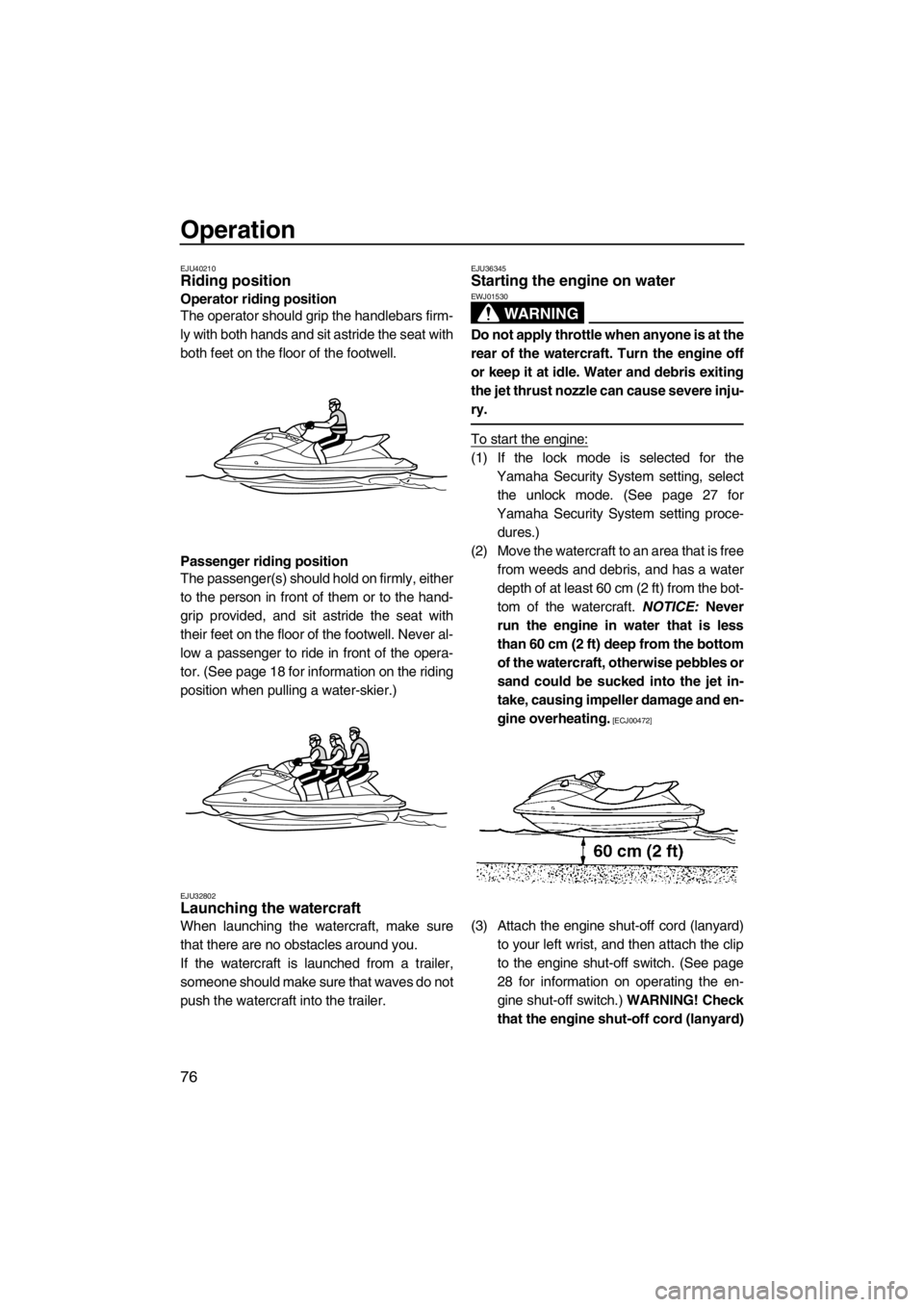
Operation
76
EJU40210Riding position
Operator riding position
The operator should grip the handlebars firm-
ly with both hands and sit astride the seat with
both feet on the floor of the footwell.
Passenger riding position
The passenger(s) should hold on firmly, either
to the person in front of them or to the hand-
grip provided, and sit astride the seat with
their feet on the floor of the footwell. Never al-
low a passenger to ride in front of the opera-
tor. (See page 18 for information on the riding
position when pulling a water-skier.)
EJU32802Launching the watercraft
When launching the watercraft, make sure
that there are no obstacles around you.
If the watercraft is launched from a trailer,
someone should make sure that waves do not
push the watercraft into the trailer.
EJU36345Starting the engine on water
WARNING
EWJ01530
Do not apply throttle when anyone is at the
rear of the watercraft. Turn the engine off
or keep it at idle. Water and debris exiting
the jet thrust nozzle can cause severe inju-
ry.
To start the engine:
(1) If the lock mode is selected for the
Yamaha Security System setting, select
the unlock mode. (See page 27 for
Yamaha Security System setting proce-
dures.)
(2) Move the watercraft to an area that is free
from weeds and debris, and has a water
depth of at least 60 cm (2 ft) from the bot-
tom of the watercraft. NOTICE: Never
run the engine in water that is less
than 60 cm (2 ft) deep from the bottom
of the watercraft, otherwise pebbles or
sand could be sucked into the jet in-
take, causing impeller damage and en-
gine overheating.
[ECJ00472]
(3) Attach the engine shut-off cord (lanyard)
to your left wrist, and then attach the clip
to the engine shut-off switch. (See page
28 for information on operating the en-
gine shut-off switch.) WARNING! Check
that the engine shut-off cord (lanyard)
UF2S70E0.book Page 76 Wednesday, December 7, 2011 3:56 PM
Page 83 of 116
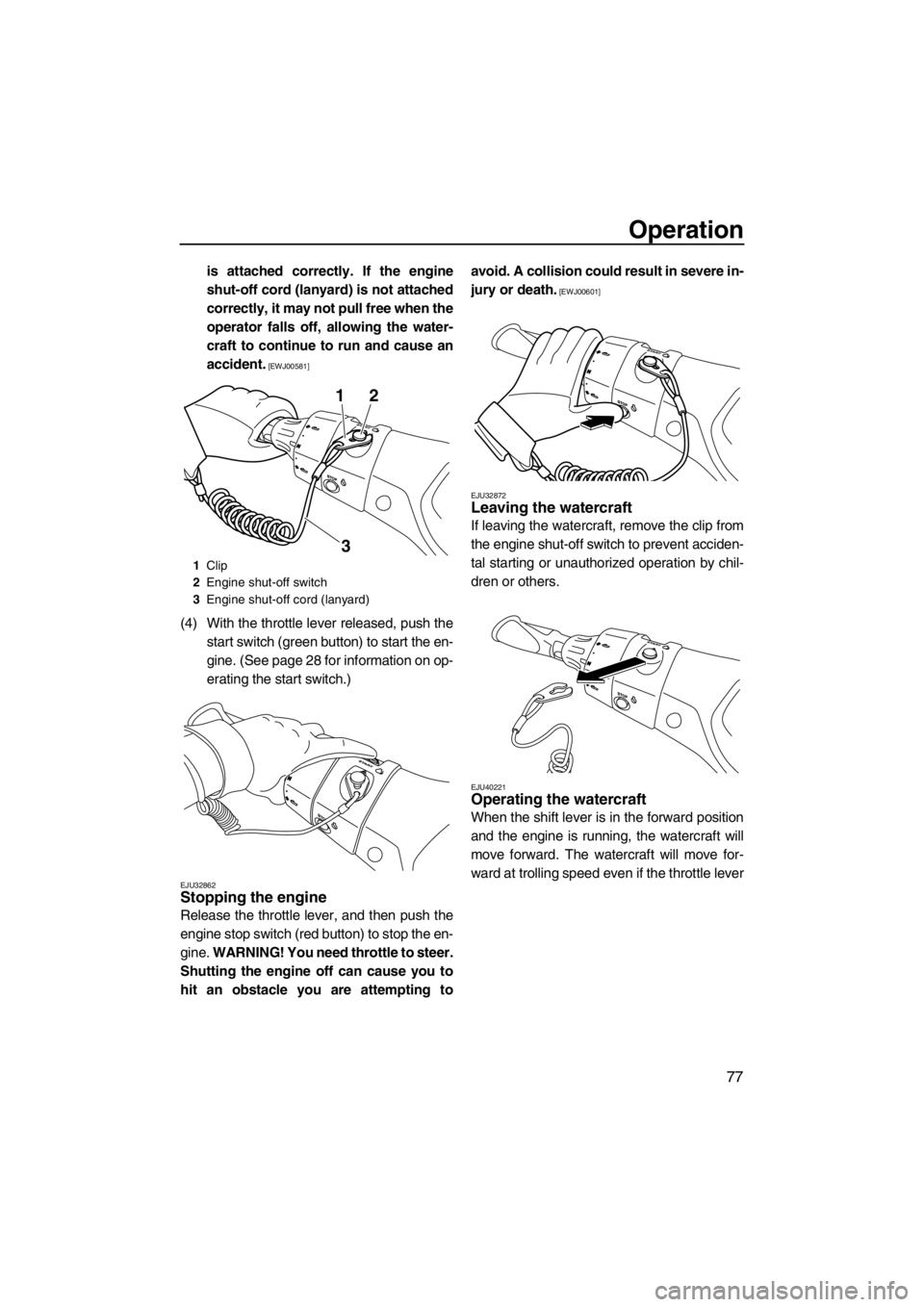
Operation
77
is attached correctly. If the engine
shut-off cord (lanyard) is not attached
correctly, it may not pull free when the
operator falls off, allowing the water-
craft to continue to run and cause an
accident.
[EWJ00581]
(4) With the throttle lever released, push the
start switch (green button) to start the en-
gine. (See page 28 for information on op-
erating the start switch.)
EJU32862Stopping the engine
Release the throttle lever, and then push the
engine stop switch (red button) to stop the en-
gine. WARNING! You need throttle to steer.
Shutting the engine off can cause you to
hit an obstacle you are attempting toavoid. A collision could result in severe in-
jury or death.
[EWJ00601]
EJU32872
Leaving the watercraft
If leaving the watercraft, remove the clip from
the engine shut-off switch to prevent acciden-
tal starting or unauthorized operation by chil-
dren or others.
EJU40221Operating the watercraft
When the shift lever is in the forward position
and the engine is running, the watercraft will
move forward. The watercraft will move for-
ward at trolling speed even if the throttle lever
1Clip
2Engine shut-off switch
3Engine shut-off cord (lanyard)
12
3
UF2S70E0.book Page 77 Wednesday, December 7, 2011 3:56 PM
Page 84 of 116
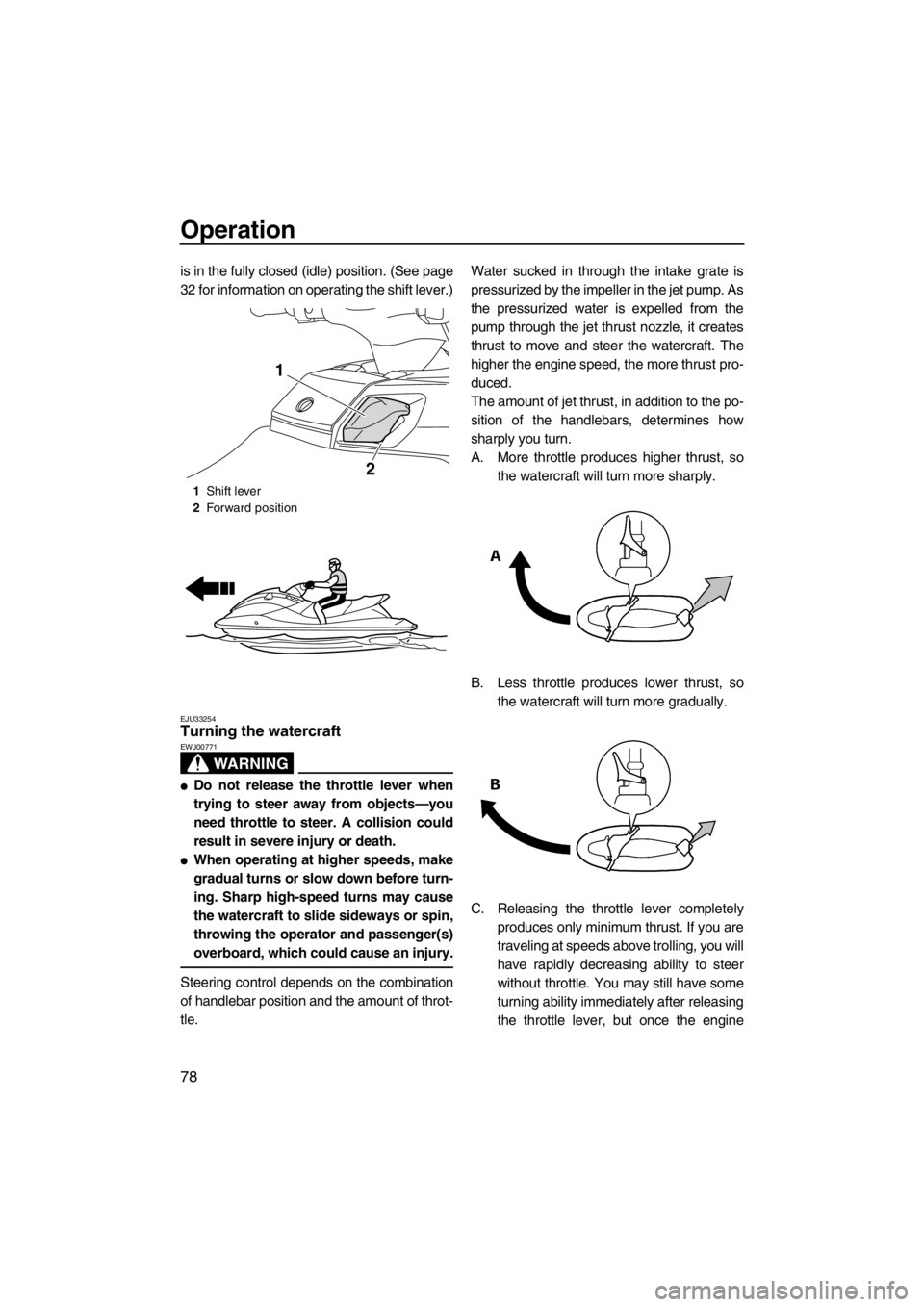
Operation
78
is in the fully closed (idle) position. (See page
32 for information on operating the shift lever.)
EJU33254Turning the watercraft
WARNING
EWJ00771
●Do not release the throttle lever when
trying to steer away from objects—you
need throttle to steer. A collision could
result in severe injury or death.
●When operating at higher speeds, make
gradual turns or slow down before turn-
ing. Sharp high-speed turns may cause
the watercraft to slide sideways or spin,
throwing the operator and passenger(s)
overboard, which could cause an injury.
Steering control depends on the combination
of handlebar position and the amount of throt-
tle.Water sucked in through the intake grate is
pressurized by the impeller in the jet pump. As
the pressurized water is expelled from the
pump through the jet thrust nozzle, it creates
thrust to move and steer the watercraft. The
higher the engine speed, the more thrust pro-
duced.
The amount of jet thrust, in addition to the po-
sition of the handlebars, determines how
sharply you turn.
A. More throttle produces higher thrust, so
the watercraft will turn more sharply.
B. Less throttle produces lower thrust, so
the watercraft will turn more gradually.
C. Releasing the throttle lever completely
produces only minimum thrust. If you are
traveling at speeds above trolling, you will
have rapidly decreasing ability to steer
without throttle. You may still have some
turning ability immediately after releasing
the throttle lever, but once the engine
1Shift lever
2Forward position
1
2
UF2S70E0.book Page 78 Wednesday, December 7, 2011 3:56 PM
Page 85 of 116
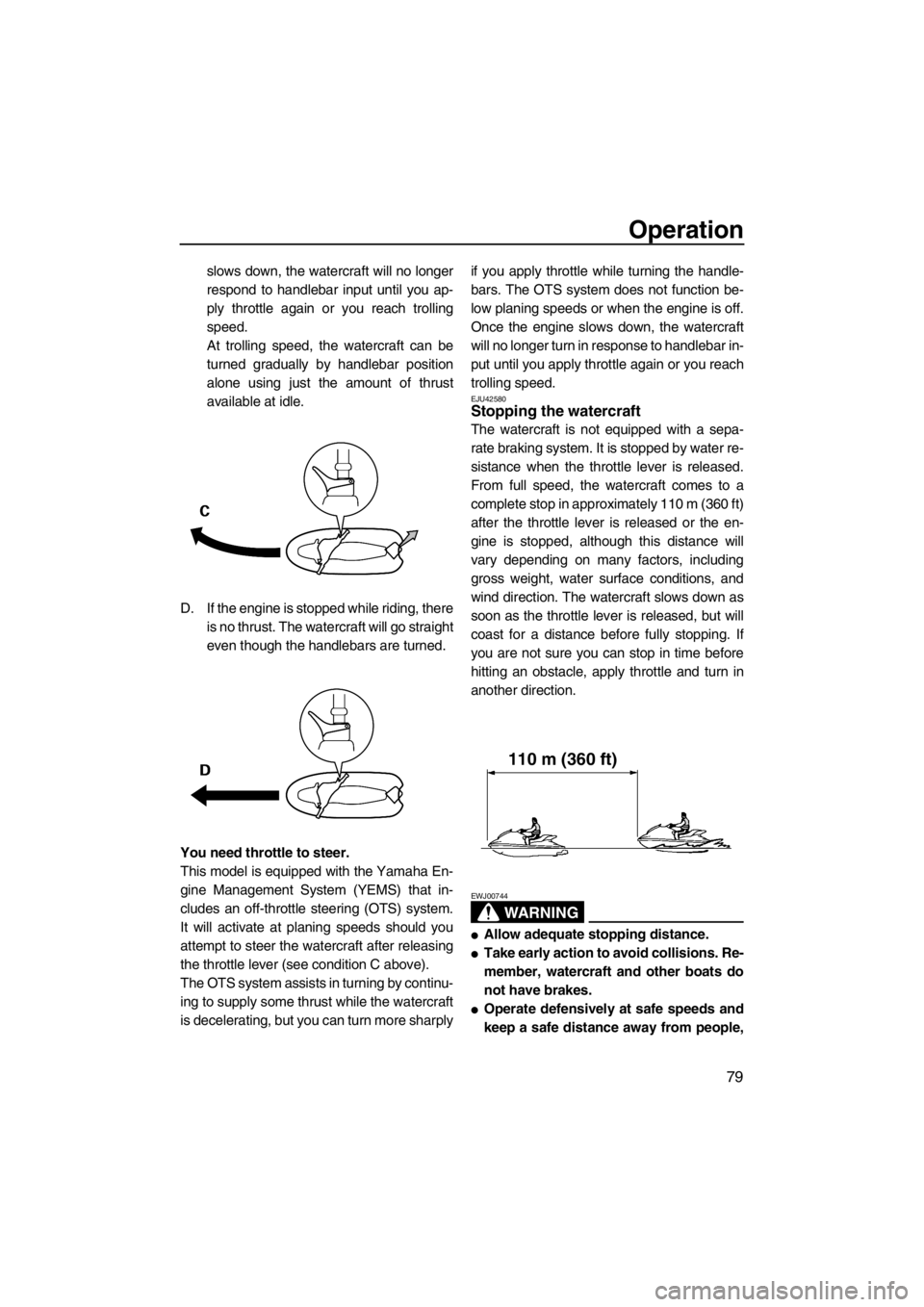
Operation
79
slows down, the watercraft will no longer
respond to handlebar input until you ap-
ply throttle again or you reach trolling
speed.
At trolling speed, the watercraft can be
turned gradually by handlebar position
alone using just the amount of thrust
available at idle.
D. If the engine is stopped while riding, there
is no thrust. The watercraft will go straight
even though the handlebars are turned.
You need throttle to steer.
This model is equipped with the Yamaha En-
gine Management System (YEMS) that in-
cludes an off-throttle steering (OTS) system.
It will activate at planing speeds should you
attempt to steer the watercraft after releasing
the throttle lever (see condition C above).
The OTS system assists in turning by continu-
ing to supply some thrust while the watercraft
is decelerating, but you can turn more sharplyif you apply throttle while turning the handle-
bars. The OTS system does not function be-
low planing speeds or when the engine is off.
Once the engine slows down, the watercraft
will no longer turn in response to handlebar in-
put until you apply throttle again or you reach
trolling speed.
EJU42580Stopping the watercraft
The watercraft is not equipped with a sepa-
rate braking system. It is stopped by water re-
sistance when the throttle lever is released.
From full speed, the watercraft comes to a
complete stop in approximately 110 m (360 ft)
after the throttle lever is released or the en-
gine is stopped, although this distance will
vary depending on many factors, including
gross weight, water surface conditions, and
wind direction. The watercraft slows down as
soon as the throttle lever is released, but will
coast for a distance before fully stopping. If
you are not sure you can stop in time before
hitting an obstacle, apply throttle and turn in
another direction.
WARNING
EWJ00744
●Allow adequate stopping distance.
●Take early action to avoid collisions. Re-
member, watercraft and other boats do
not have brakes.
●Operate defensively at safe speeds and
keep a safe distance away from people,
110 m (360 ft)
UF2S70E0.book Page 79 Wednesday, December 7, 2011 3:56 PM
Page 86 of 116
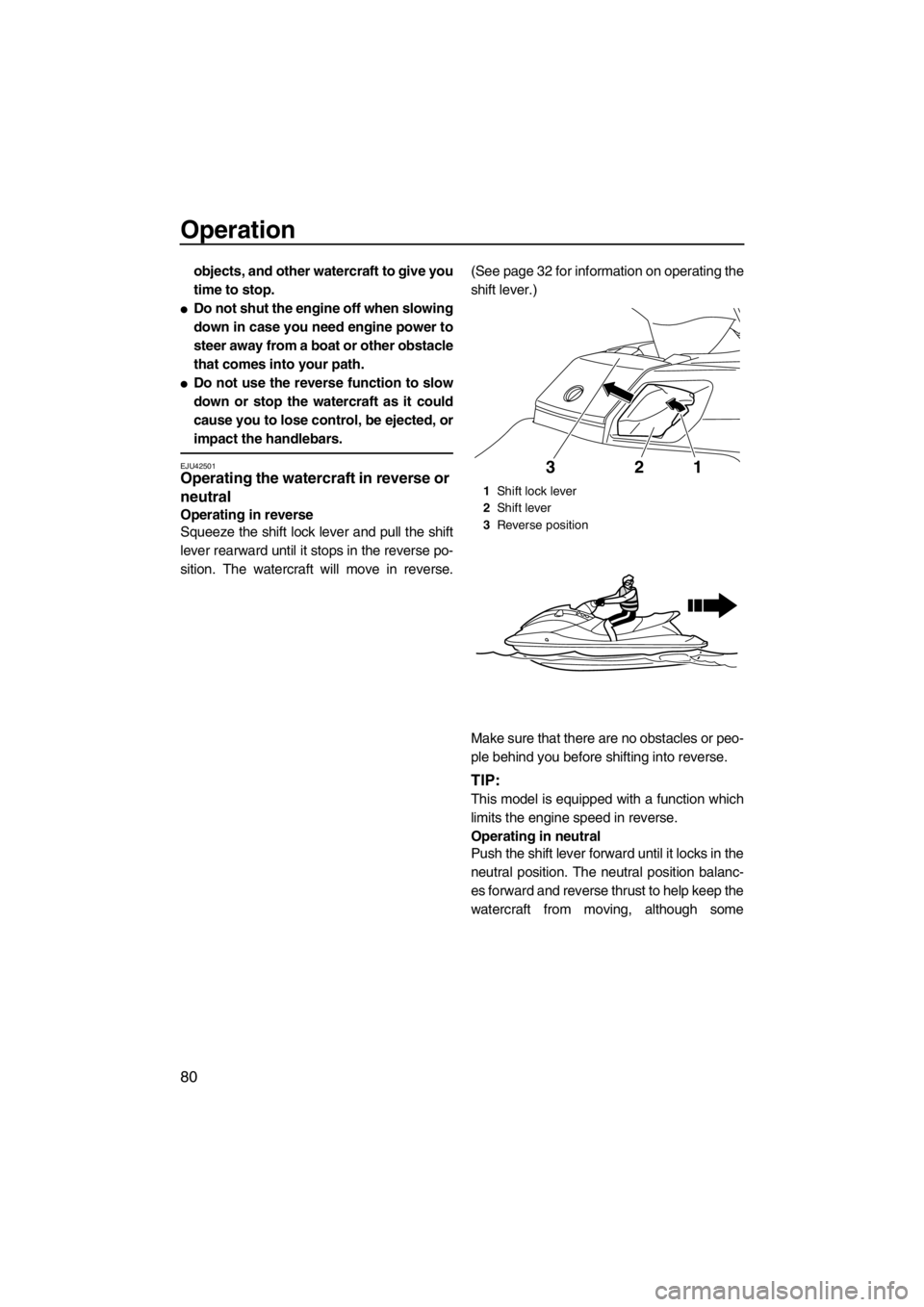
Operation
80
objects, and other watercraft to give you
time to stop.
●Do not shut the engine off when slowing
down in case you need engine power to
steer away from a boat or other obstacle
that comes into your path.
●Do not use the reverse function to slow
down or stop the watercraft as it could
cause you to lose control, be ejected, or
impact the handlebars.
EJU42501Operating the watercraft in reverse or
neutral
Operating in reverse
Squeeze the shift lock lever and pull the shift
lever rearward until it stops in the reverse po-
sition. The watercraft will move in reverse.(See page 32 for information on operating the
shift lever.)
Make sure that there are no obstacles or peo-
ple behind you before shifting into reverse.
TIP:
This model is equipped with a function which
limits the engine speed in reverse.
Operating in neutral
Push the shift lever forward until it locks in the
neutral position. The neutral position balanc-
es forward and reverse thrust to help keep the
watercraft from moving, although some
1Shift lock lever
2Shift lever
3Reverse position
2 31
UF2S70E0.book Page 80 Wednesday, December 7, 2011 3:56 PM
Page 87 of 116
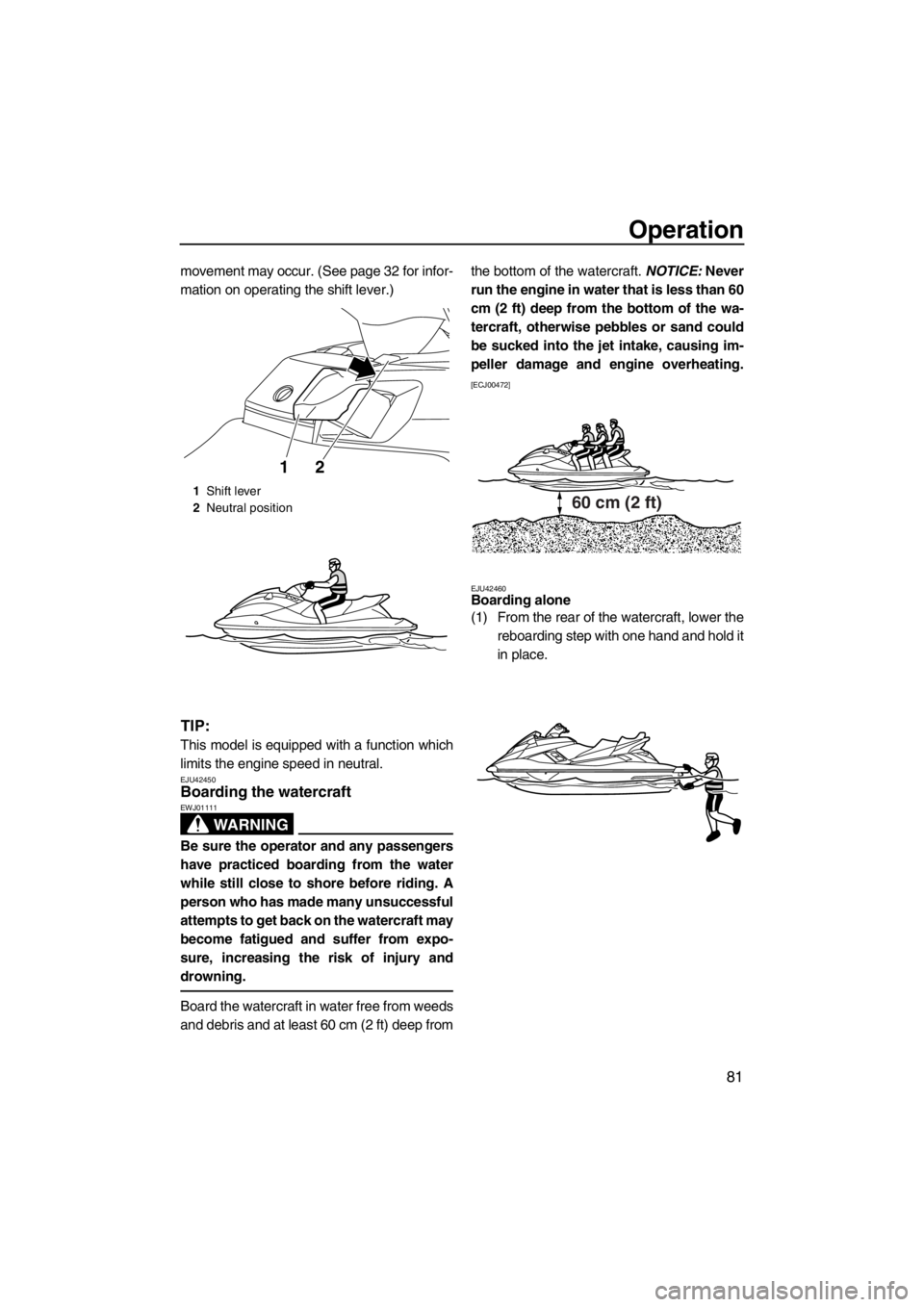
Operation
81
movement may occur. (See page 32 for infor-
mation on operating the shift lever.)
TIP:
This model is equipped with a function which
limits the engine speed in neutral.
EJU42450Boarding the watercraft
WARNING
EWJ01111
Be sure the operator and any passengers
have practiced boarding from the water
while still close to shore before riding. A
person who has made many unsuccessful
attempts to get back on the watercraft may
become fatigued and suffer from expo-
sure, increasing the risk of injury and
drowning.
Board the watercraft in water free from weeds
and debris and at least 60 cm (2 ft) deep fromthe bottom of the watercraft. NOTICE: Never
run the engine in water that is less than 60
cm (2 ft) deep from the bottom of the wa-
tercraft, otherwise pebbles or sand could
be sucked into the jet intake, causing im-
peller damage and engine overheating.
[ECJ00472]
EJU42460
Boarding alone
(1) From the rear of the watercraft, lower the
reboarding step with one hand and hold it
in place.
1Shift lever
2Neutral position
12
60 cm (2 ft)
UF2S70E0.book Page 81 Wednesday, December 7, 2011 3:56 PM
Page 88 of 116
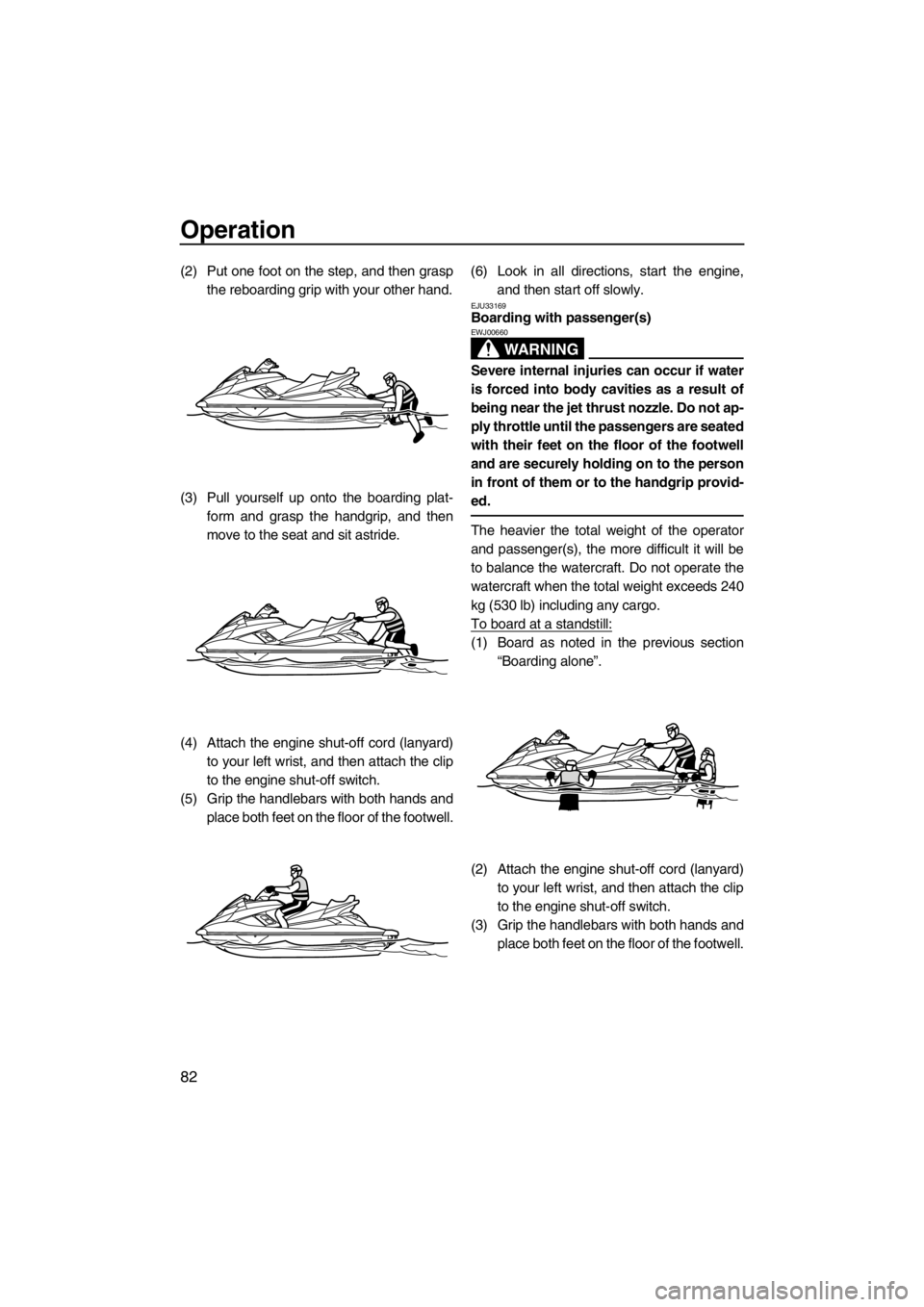
Operation
82
(2) Put one foot on the step, and then grasp
the reboarding grip with your other hand.
(3) Pull yourself up onto the boarding plat-
form and grasp the handgrip, and then
move to the seat and sit astride.
(4) Attach the engine shut-off cord (lanyard)
to your left wrist, and then attach the clip
to the engine shut-off switch.
(5) Grip the handlebars with both hands and
place both feet on the floor of the footwell.(6) Look in all directions, start the engine,
and then start off slowly.
EJU33169Boarding with passenger(s)
WARNING
EWJ00660
Severe internal injuries can occur if water
is forced into body cavities as a result of
being near the jet thrust nozzle. Do not ap-
ply throttle until the passengers are seated
with their feet on the floor of the footwell
and are securely holding on to the person
in front of them or to the handgrip provid-
ed.
The heavier the total weight of the operator
and passenger(s), the more difficult it will be
to balance the watercraft. Do not operate the
watercraft when the total weight exceeds 240
kg (530 lb) including any cargo.
To board at a standstill:
(1) Board as noted in the previous section
“Boarding alone”.
(2) Attach the engine shut-off cord (lanyard)
to your left wrist, and then attach the clip
to the engine shut-off switch.
(3) Grip the handlebars with both hands and
place both feet on the floor of the footwell.
UF2S70E0.book Page 82 Wednesday, December 7, 2011 3:56 PM
Page 89 of 116
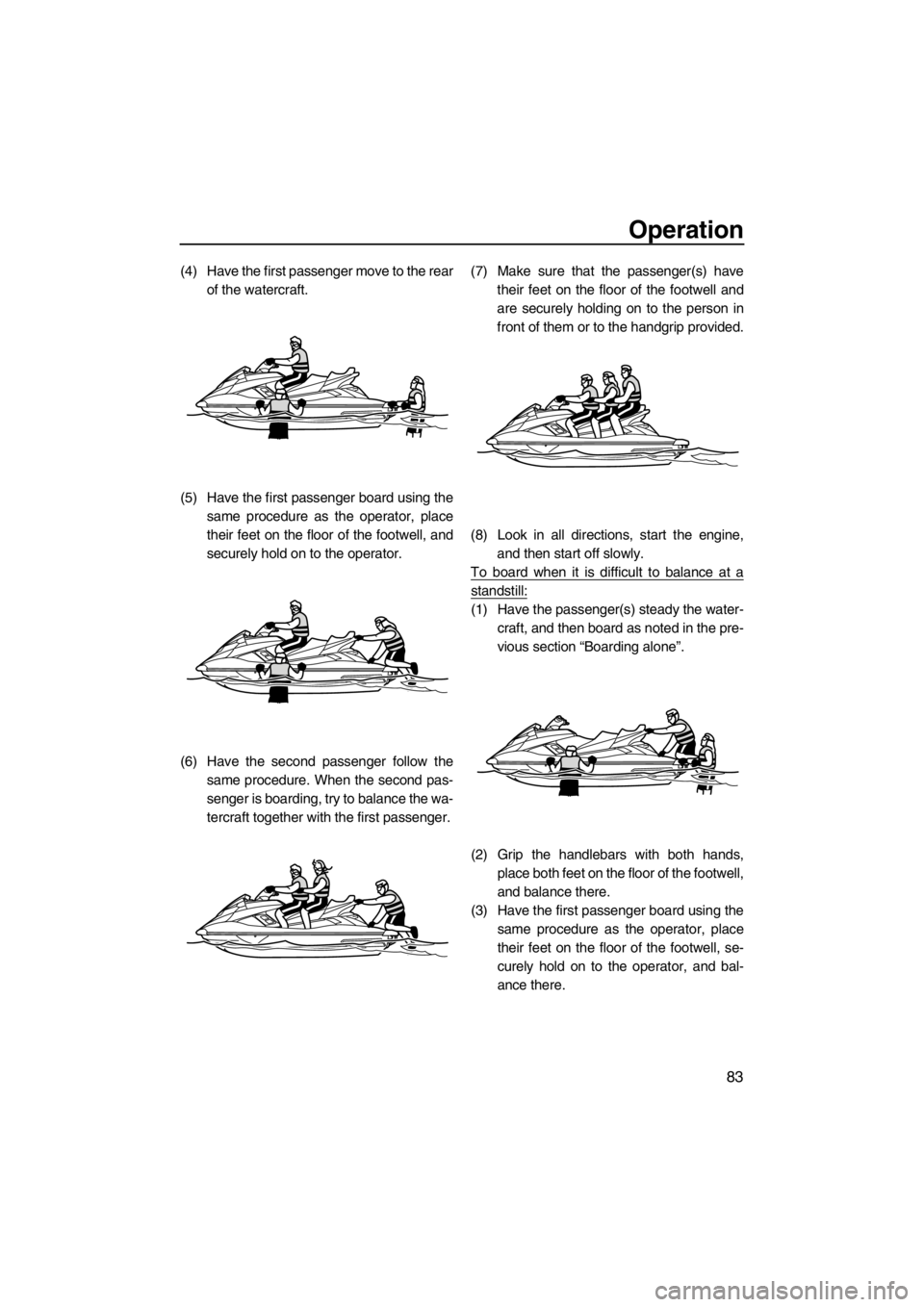
Operation
83
(4) Have the first passenger move to the rear
of the watercraft.
(5) Have the first passenger board using the
same procedure as the operator, place
their feet on the floor of the footwell, and
securely hold on to the operator.
(6) Have the second passenger follow the
same procedure. When the second pas-
senger is boarding, try to balance the wa-
tercraft together with the first passenger.(7) Make sure that the passenger(s) have
their feet on the floor of the footwell and
are securely holding on to the person in
front of them or to the handgrip provided.
(8) Look in all directions, start the engine,
and then start off slowly.
To board when it is difficult to balance at a
standstill:
(1) Have the passenger(s) steady the water-
craft, and then board as noted in the pre-
vious section “Boarding alone”.
(2) Grip the handlebars with both hands,
place both feet on the floor of the footwell,
and balance there.
(3) Have the first passenger board using the
same procedure as the operator, place
their feet on the floor of the footwell, se-
curely hold on to the operator, and bal-
ance there.
UF2S70E0.book Page 83 Wednesday, December 7, 2011 3:56 PM
Page 90 of 116
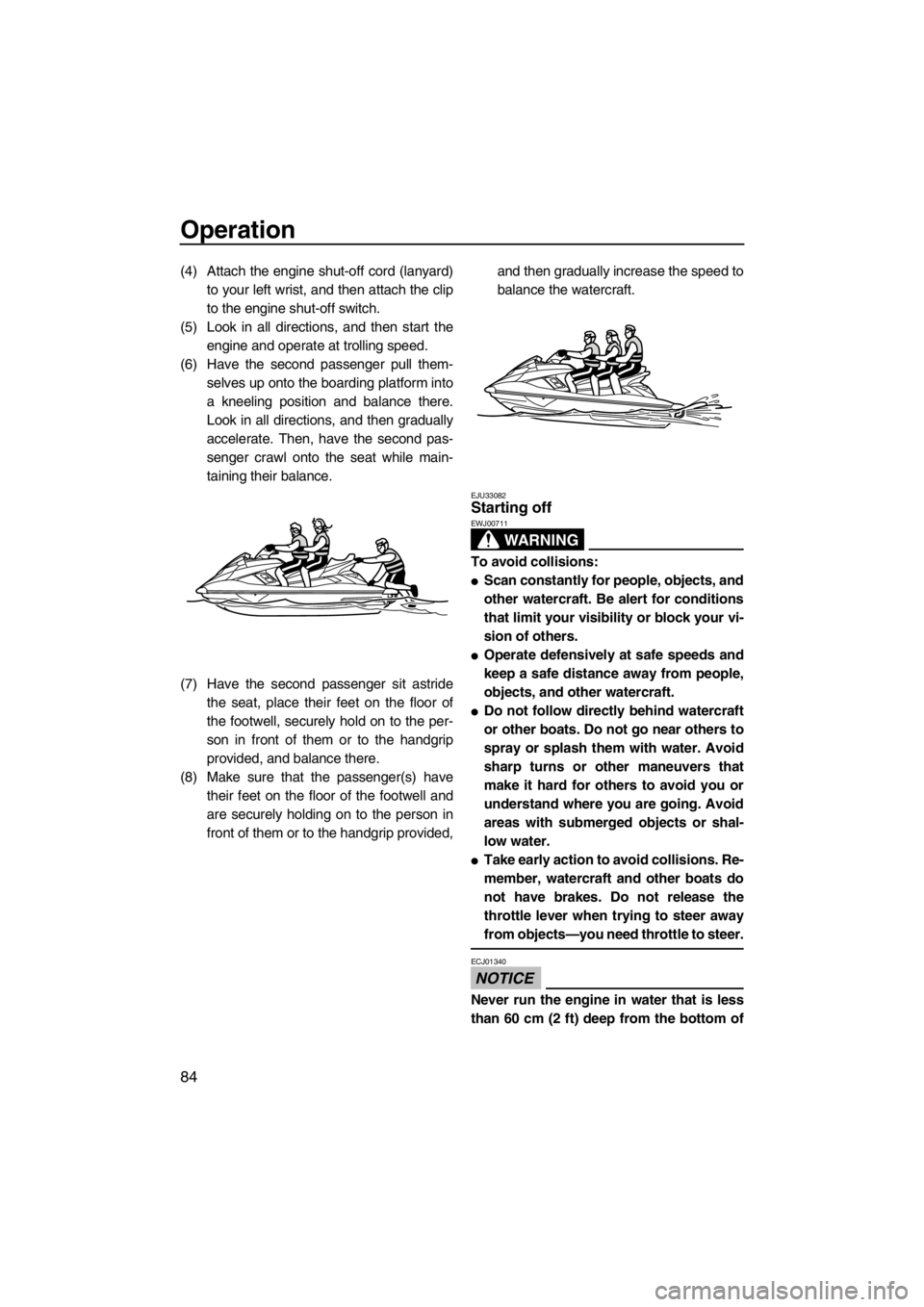
Operation
84
(4) Attach the engine shut-off cord (lanyard)
to your left wrist, and then attach the clip
to the engine shut-off switch.
(5) Look in all directions, and then start the
engine and operate at trolling speed.
(6) Have the second passenger pull them-
selves up onto the boarding platform into
a kneeling position and balance there.
Look in all directions, and then gradually
accelerate. Then, have the second pas-
senger crawl onto the seat while main-
taining their balance.
(7) Have the second passenger sit astride
the seat, place their feet on the floor of
the footwell, securely hold on to the per-
son in front of them or to the handgrip
provided, and balance there.
(8) Make sure that the passenger(s) have
their feet on the floor of the footwell and
are securely holding on to the person in
front of them or to the handgrip provided,and then gradually increase the speed to
balance the watercraft.
EJU33082Starting off
WARNING
EWJ00711
To avoid collisions:
●Scan constantly for people, objects, and
other watercraft. Be alert for conditions
that limit your visibility or block your vi-
sion of others.
●Operate defensively at safe speeds and
keep a safe distance away from people,
objects, and other watercraft.
●Do not follow directly behind watercraft
or other boats. Do not go near others to
spray or splash them with water. Avoid
sharp turns or other maneuvers that
make it hard for others to avoid you or
understand where you are going. Avoid
areas with submerged objects or shal-
low water.
●Take early action to avoid collisions. Re-
member, watercraft and other boats do
not have brakes. Do not release the
throttle lever when trying to steer away
from objects—you need throttle to steer.
NOTICE
ECJ01340
Never run the engine in water that is less
than 60 cm (2 ft) deep from the bottom of
UF2S70E0.book Page 84 Wednesday, December 7, 2011 3:56 PM